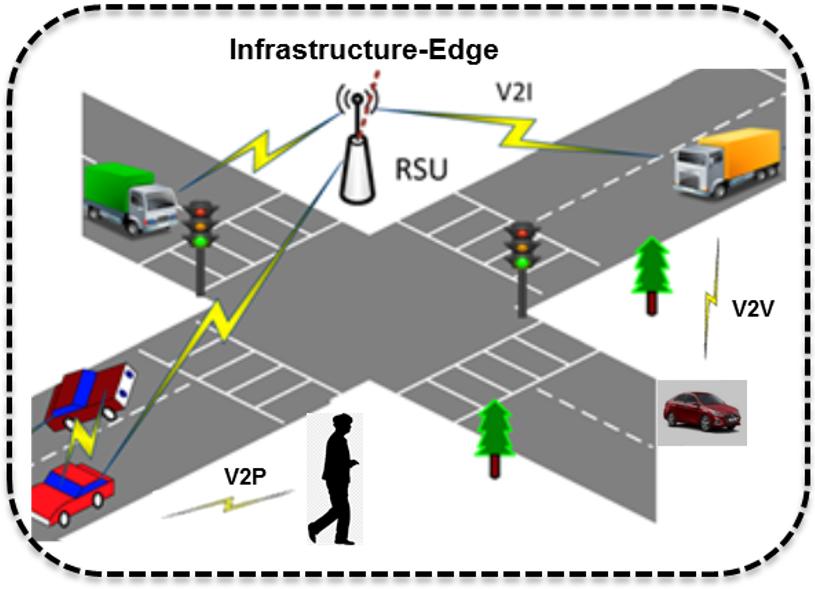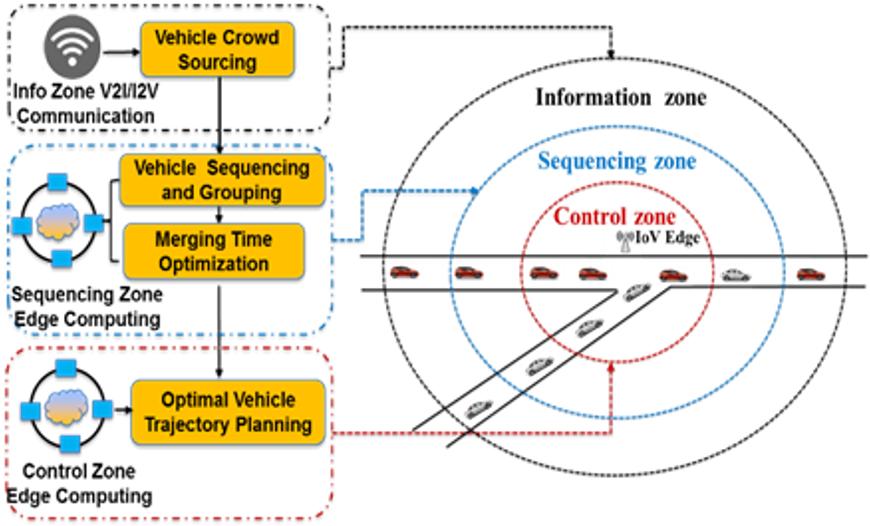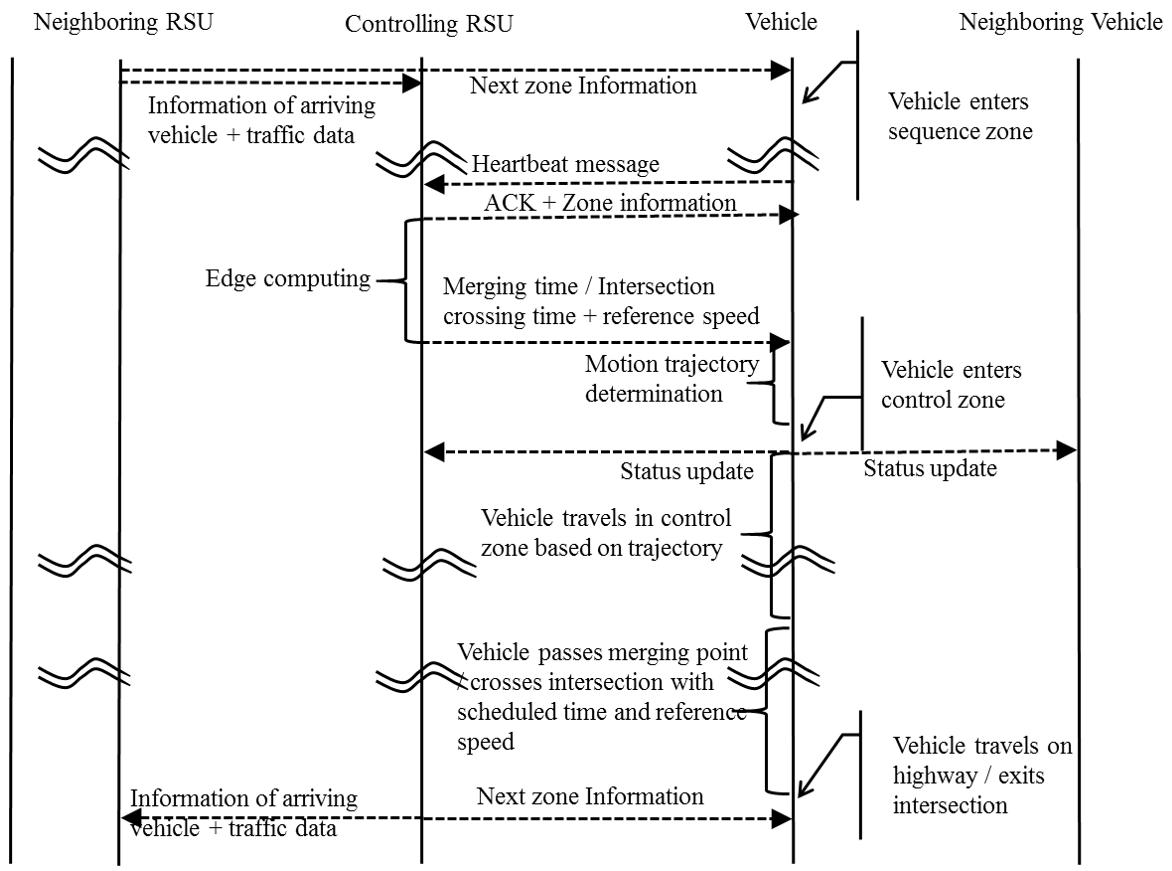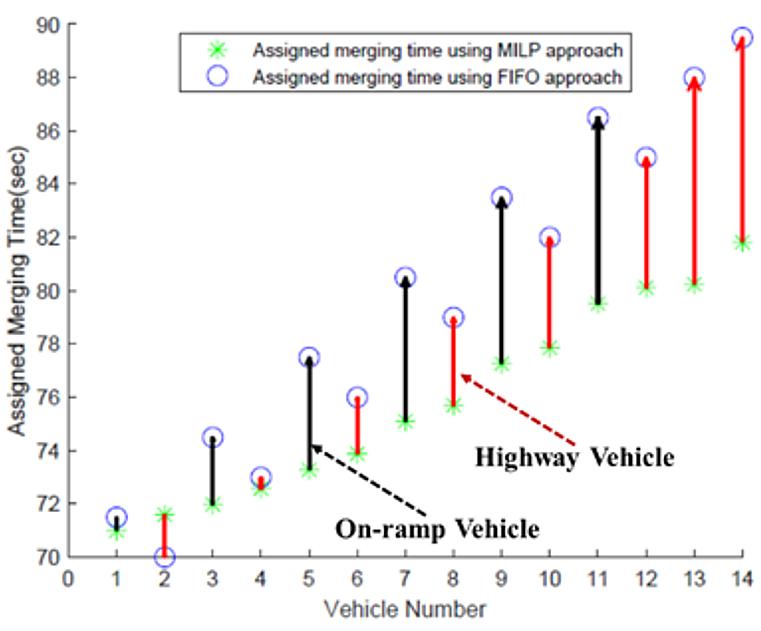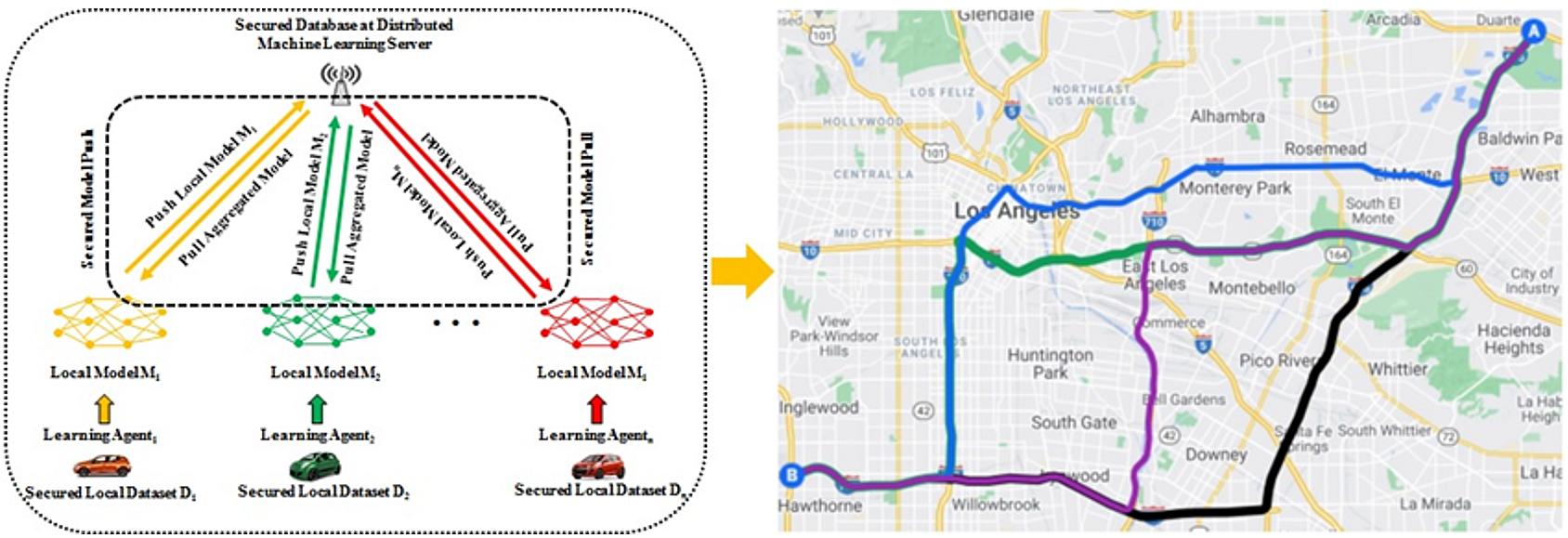Edge-Assisted Internet of Vehicles for Smart Mobility
A new paradigm for connected and automated driving.
MERL Researchers: Jianlin Guo, Kyeong Jin (KJ) Kim, Kieran Parsons, Philip V. Orlik, Stefano Di Cairano.
Search MERL publications by keyword: Internet of Vehicles, interconnected intersection, federated learning, traffic prediction, route planning,
Problems and motivation
Intelligent transportation is a key component to enable Smart Cities. However, vehicular systems are highly complex and dynamic, where mobile vehicles, pedestrians, road conditions, driver characteristics and weather all play important roles. Connected and automated vehicles (CAVs), with the assistance of infrastructure units, allow for sensing and control information to be communicated and acted upon to achieve intelligent transportation goals.
Edge-assisted IoV reduces communication latency for real-time operation and utilizes the advanced features and data collection methods of the connected and automated vehicles to realize smart mobility functions. How to best utilize connected and automated vehicles to improve smart city traffic has attracted significant research attention.
Increasing the intelligence of the vehicle and infrastructure and improving vehicle-to-infrastructure collaboration are key enablers to make traffic systems smarter and more efficient. MERL aims to add intelligence to both vehicle and infrastructure components and has developed edge-assisted optimal highway merging and intersection passing technologies and federated learning technologies for optimal path planning.
Zone-based vehicle control
Cloud computing cannot realize real time vehicle control due to its long communication latency and on-board control does not have sufficient data to make global optimal decisions. Edge computing techniques can overcome cloud control latency and on-board control sub-optimization. MERL has developed a zone-based vehicle control method, in which road sections at highway merging points or intersections are divided into i) an information zone where vehicles and the IoV edge device exchange information; ii) a sequence zone where the IoV edge groups vehicles and schedules optimal times for each vehicle to arrive at the highway merging point or intersection crossing line; and iii) a control zone where the vehicle trajectories are optimized for fuel efficiency and driving comfort.
In the zone-based vehicle control model, infrastructure units (e.g., RSU or eNodeB) and vehicles collaboratively make optimal control decisions. To that end, V2I and V2V communication is critical. MERL has developed a communication protocol to realize information and control decision exchange suitable for this application.
The optimal highway merging and interconnected intersection passing are formulated as mixed integer linear programming (MILP) problems and compared with a first-in-first-out (FIFO)/first-come-first-serve (FCFS) method. The proposed technologies improve average time of highway merging by 21% and the maximum travel time of intersection passing by 4.7%.
A demonstration of optimal intersection passing and highway merging using MERL technology is shown in the videos below.
Distributed machine learning for traffic prediction in IoV
Modern vehicles are equipped with numerous sensors to collect data. These data can be useful to optimize the performance of the individual vehicles and the transportation network as a whole. However, uploading large amounts of raw data from the vehicles to the IoV edge requires enormous communication bandwidth and introduces significant privacy concerns. On the other hand, the data collected by individual vehicles may not be sufficient to train a model applicable to a wide area suitable for making robust and correct decisions. MERL has developed multi-task federated learning technologies to address the data privacy concerns, communication bandwidth limitations, and data heterogeneity in IoV. In our learning model, the IoV edge acts as a learning server and data collector and vehicles act as learning agents. The learning server and learning agents perform federated learning to jointly predict travel time and generate a time-dependent graph that can be used to determine the optimal route. In the figure below, the Google Map-like method selects the black route all day. On the other hand, the proposed federated learning-based technology selects routes depending on the time (black, green, purple, and blue routes are selected at 12 AM, 7 AM, 5 PM and 7 PM, respectively). The predicted travel time is nearly same as actual travel time.
MERL continues to research smart mobility technologies to address the distributed machine learning challenges caused by high mobility and unreliable communication in the vehicular environment in order to provide secure and efficient methods to optimize network performance.
Use cases
Smart city transportation, in-vehicle ADAS system, roadside equipment, on-board equipment, and autonomous driving.
MERL Publications
- , "Multi-Task Federated Learning for Traffic Prediction and Its Application to Route Planning", IEEE Intelligent Vehicles Symposium, July 2021.BibTeX TR2021-083 PDF Video
- @inproceedings{Zeng2021jul,
- author = {Zeng, Tengchan and Guo, Jianlin and Kim, Kyeong Jin and Parsons, Kieran and Orlik, Philip V. and {Di Cairano}, Stefano and Saad, Walid},
- title = {{Multi-Task Federated Learning for Traffic Prediction and Its Application to Route Planning}},
- booktitle = {IEEE Intelligent Vehicles Symposium},
- year = 2021,
- month = jul,
- url = {https://www.merl.com/publications/TR2021-083}
- }
- , "Edge Computing for Interconnected Intersections in Internet of Vehicles", IEEE Intelligent Vehicles Symposium, June 2020, pp. 209-215.BibTeX TR2020-081 PDF
- @inproceedings{Lee2020jun,
- author = {Lee, Gilsoo and Guo, Jianlin and Kim, Kyeong Jin and Orlik, Philip V. and Ahn, Heejin and {Di Cairano}, Stefano and Saad, Walid},
- title = {{Edge Computing for Interconnected Intersections in Internet of Vehicles}},
- booktitle = {IEEE Intelligent Vehicles Symposium},
- year = 2020,
- pages = {209--215},
- month = jun,
- isbn = {978-1-7281-6672-8},
- url = {https://www.merl.com/publications/TR2020-081}
- }
- , "Bi-level Optimal Edge Computing Model for On-ramp Merging in Connected Vehicle Environment", IEEE Intelligent Vehicle Symposium, DOI: 10.1109/IVS.2019.8814096, June 2019, pp. 2005-2011.BibTeX TR2019-163 PDF
- @inproceedings{Ye2019jun,
- author = {Ye, Fei and Guo, Jianlin and Kim, Kyeong Jin and Orlik, Philip V. and Ahn, Heejin and {Di Cairano}, Stefano},
- title = {{Bi-level Optimal Edge Computing Model for On-ramp Merging in Connected Vehicle Environment}},
- booktitle = {IEEE Intelligent Vehicle Symposium},
- year = 2019,
- pages = {2005--2011},
- month = jun,
- doi = {10.1109/IVS.2019.8814096},
- url = {https://www.merl.com/publications/TR2019-163}
- }
- , "Model Predictive Control Approach for Autonomous Sun-Synchronous Sub-Recurrent Orbit Control", AIAA SciTech, DOI: 10.2514/6.2021-1953, January 2021.BibTeX TR2021-005 PDF
- @inproceedings{Hayashi2021jan,
- author = {Hayashi, Naohiro and Weiss, Avishai and {Di Cairano}, Stefano},
- title = {{Model Predictive Control Approach for Autonomous Sun-Synchronous Sub-Recurrent Orbit Control}},
- booktitle = {AIAA SciTech},
- year = 2021,
- month = jan,
- publisher = {AIAA},
- doi = {10.2514/6.2021-1953},
- url = {https://www.merl.com/publications/TR2021-005}
- }
- , "Improving Passenger Comfort by Exploiting Hub Motors in Electric Vehicles: Suspension Modeling", ASME Dynamic Systems and Control Conference (DSCC), DOI: 10.1115/DSCC2020-3167, January 2021.BibTeX TR2021-019 PDF
- @inproceedings{Chen2021jan,
- author = {Chen, Di and Danielson, Claus and Masahiro, Iezawa},
- title = {{Improving Passenger Comfort by Exploiting Hub Motors in Electric Vehicles: Suspension Modeling}},
- booktitle = {ASME Dynamic Systems and Control Conference (DSCC)},
- year = 2021,
- month = jan,
- doi = {10.1115/DSCC2020-3167},
- url = {https://www.merl.com/publications/TR2021-019}
- }
